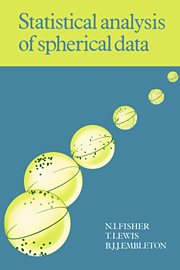Book contents
- Frontmatter
- Contents
- Preface
- 1 Introduction
- 2 Terminology and spherical coordinate systems
- 3 Descriptive and ancillary methods, and sampling problems
- 4 Models
- 5 Analysis of a single sample of unit vectors
- 6 Analysis of a single sample of undirected lines
- 7 Analysis of two or more samples of vectorial or axial data
- 8 Correlation, regression and temporal/spatial analysis
- Appendix A Tables and charts
- Appendix B Data sets
- References
- Index
2 - Terminology and spherical coordinate systems
Published online by Cambridge University Press: 06 January 2010
- Frontmatter
- Contents
- Preface
- 1 Introduction
- 2 Terminology and spherical coordinate systems
- 3 Descriptive and ancillary methods, and sampling problems
- 4 Models
- 5 Analysis of a single sample of unit vectors
- 6 Analysis of a single sample of undirected lines
- 7 Analysis of two or more samples of vectorial or axial data
- 8 Correlation, regression and temporal/spatial analysis
- Appendix A Tables and charts
- Appendix B Data sets
- References
- Index
Summary
Introduction
Many different ways of representing a three-dimensional unit vector or axis have been developed over the centuries, due not only to the requirements of different disciplines (Astronomy, Geodesy, Geology, Geophysics, Mathematics, …) but also to diverse needs within a discipline: in Geology, for example, there appear to be five or six systems in current use. In this book, we shall use either polar coordinates or the corresponding direction cosines for all purposes of statistical analysis. The following sub-section (§2.2) defines several of the coordinate systems and gives the mathematical relationship of each to polar coordinates.
Later chapters of this book, concerned with statistical analysis, abound with words and phrases which have particular meanings in Statistics, and, possibly, rather different meanings in other areas. A good example of this is the word “sample”, which for our purposes is loosely taken to mean a collection of measurements of a particular characteristic, but which has a general scientific meaning of an observational or sampling unit (e.g. a drill-core specimen on which a single measurement may be made). §2.3 gives definitions of a number of such words and phrases.
Spherical coordinate systems
The type of data we shall be dealing with will be either directed lines or undirected lines. For the former, the measurements will be unit vectors, such as the direction of magnetisation of a rock specimen, or the direction of palaeocurrent flow. For the latter, which we shall term axes (cf. §2.3), the line measured might be the normal to a fracture plane, and so have no sense (direction) unless this is ascribed on some other basis.
Information
- Type
- Chapter
- Information
- Statistical Analysis of Spherical Data , pp. 17 - 28Publisher: Cambridge University PressPrint publication year: 1987
Accessibility standard: Unknown
Why this information is here
This section outlines the accessibility features of this content - including support for screen readers, full keyboard navigation and high-contrast display options. This may not be relevant for you.Accessibility Information
- 2
- Cited by
